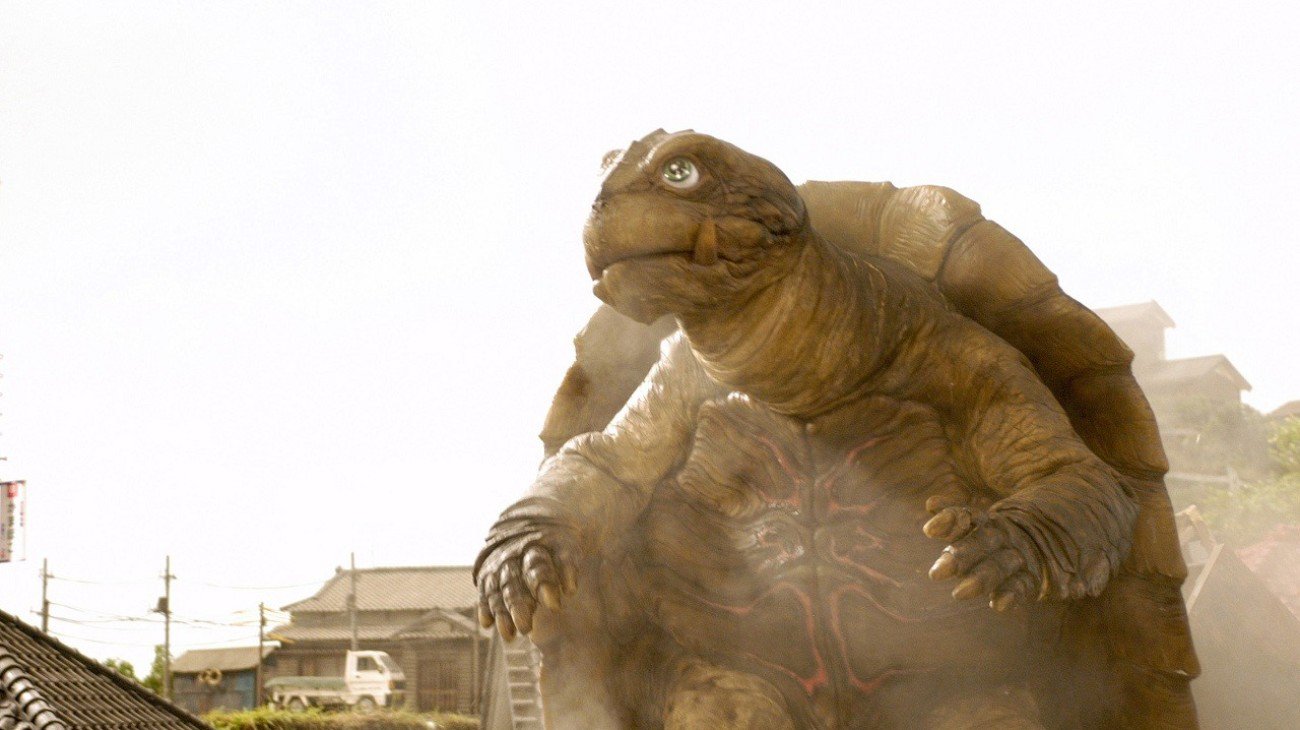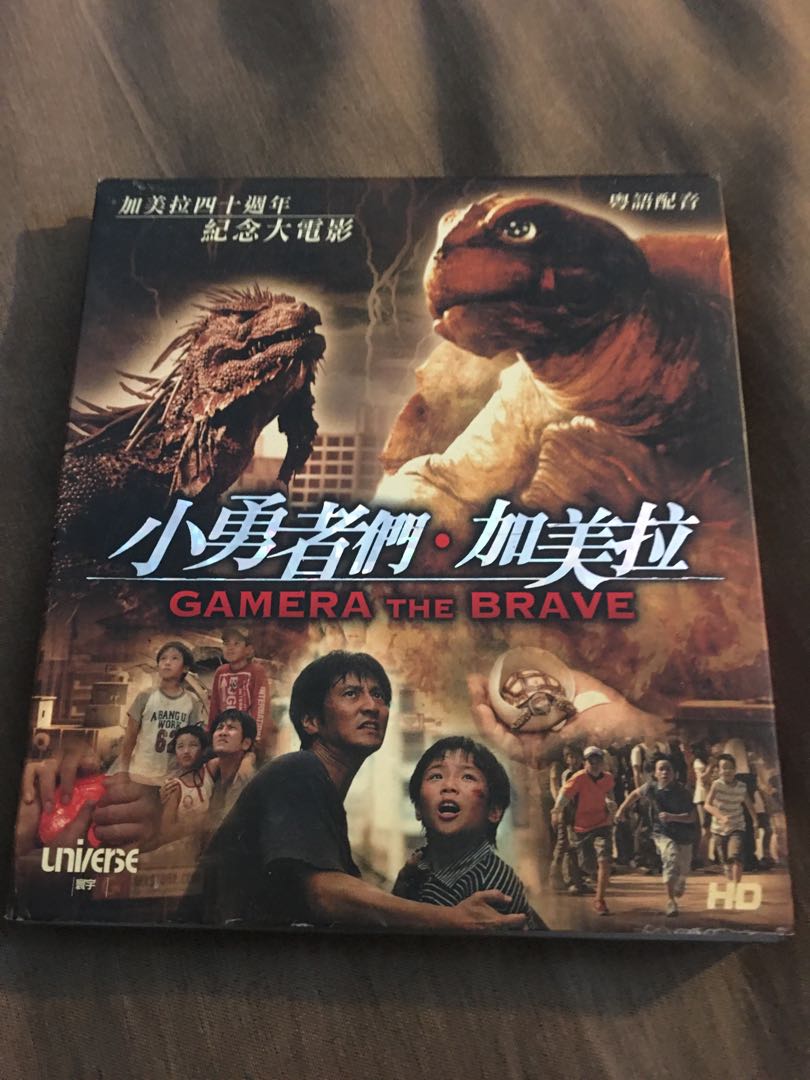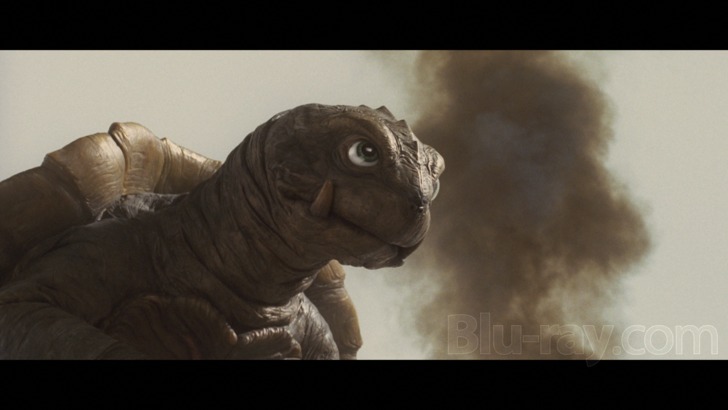http://tvtropes.org/pmwiki/pmwiki.php/Film/GameraTheBrave
Gamera film series. The Gamera Heisei series began in 1995 with the release of Gamera: Guardian of the Universe and ended in 2006 with Gamera: The Brave. The first three Heisei Gamera films were directed by Shusuke Kaneko and all share continuity, while Gamera: The Brave was released much later by Kadokawa and is a standalone film. Gamera the Brave. Original Title: 小さき勇者たち ガメラ.
Go To
Advertisement:
Gamera the Brave is a 2006 film and the fourth Gamera film to be released in the Heisei era. With no relation to the previous three films, it was intended as a full reboot of the franchise. It is directed by Ryuta Tasaki (Power Rangers, Super Sentai, Kamen Rider, Pretty Guardian Sailor Moon) with the screenplay by Yukari Tatsui.
The plot begins in the 1970s, with Gamera sacrificing himself to save a village from a swarm of Gyaos. The plot then moves forward about thirty years or so and shifts focus onto a young boy named Toru as he finds and raises a small turtle named Toto, who is actually a baby Gamera. Meanwhile, a giant monster named Zedus appears and begins eating people, and Toto grows ever larger and stronger. Eventually, the two monsters fight, but Toto is badly injured and Zedus is only temporarily deterred. In the end, though, Toto (now a fully grown Gamera) engages Zedus in another battle and emerges victorious.

Advertisement:

The film was released on April 29, 2006. Despite a positive reception from critics and fans, a sequel never materialized and the franchise once again fell into a period of hibernation that wouldn't be ended this time until 2015.

This film contains examples of the following:
- Age Cut: Kousuke is shown as a young boy witnessing Gamera's final battle with the gyaos in 1973, with a dissolve cut to 2006 where he is standing in the same spot remembering; only now he's a grown man with a child of his own.
- Big Bad: The maneating Sea Monster Zedus is the main antagonist of the film.
- Big Damn Heroes: Toto conveniently crashing into Zedus before the latter could devour Toru's Dad and Katsuya.
- A Boy and His X: Toru and Toto. Their bond is a plot point of the film
- Breath Weapon: Initially, Toto can only burp little bursts of fire, but by the end of the movie he can launch full-powered fireballs.
- Combat Tentacles: Zedus can extend his tongue to great lengths and repeatedly uses it to impale Toto.
- Continuity Reboot: A fairly good one. Kaiju were prevalent in the 1960s to 1970s but haven't been since since, and everyone was familiar with Gamera and the gyaos from the opening scene which implies a version of events similar to the Showa series happened with some Heisei influence. However no kaiju have been seen in the 30 years since, leading to a Japan unprepared for Zedus.
- Giant Flyer: Toto. Like all other Gameras.
- Gratuitous English: Toru spends much of the film wearing a t-shirt that reads, in large bold letters, 'A BANG UP WORK.' The song played over the end credits, 'Eternal Love' by the singer, mink, also scatters numerous English words and phrases throughout its lyrics.
- Heroic Sacrifice: The adult Gamera in the prologue blows himself up to kill several attacking Gyaos. The possibility of Toto doing this to stop Zedus is also a fairly major plot point.
- Ill Girl: Mai Nishio, Toru's neighbor.
- Knight of Cerebus: Zedus. The film keeps a light-hearted tone for most of the first act, but the second Zedus enters the story, everything goes to hell.
- Lighter and Softer: More optimistic than the Heisei series, but the movie opens with adult Gamera's death, how the death of his mother impacted Toru's life, and the people devoured by Zedus. Still there aren't any human antagonists, the governmental body responsible for the dark lab studying monsters is actually trying to help Toto, and all the protagonists live with better lives at the end.
- Missing Mom: Miyuki Aizawa had died in a car crash, which has made Toru fairly cynical.
- Mythology Gag: While exploring Kousuke Aizawa's kitchen, Toto is nearly hit by a dropped knife and breathes fire on it in retaliation. The knife is a reference to the knife-headed monster Guiron, from the Showa era.
- Plot-Relevant Age-Up: In the space of a week, Toto grows from a cute little turtle to a cute house-sized turtle.
- Reconstruction: Of the lighter elements of the franchise largely absent in the later entries in the Heisei trilogy. It returns to the Showa era's focus on children, but combines it with the Heisei era's tone and good writing.
- Revisiting the Roots: This film harkens back to the classic Showa Era films' roots with a more kid-focused adventure with a major lighthearted feeling, that said it still keeps a lot of the Heisei's era tone and seriousness in regards to the monster.
- Sea Monster: Zedus just kind of shows up out of the ocean one day. The first scene which foreshadows him is rather Jaws-esque with him not being shown at all.
- Shout-Out: Sgt. Frog - Toru has to remain polite to Mai in order to borrow issues from her.
- In something of a hat-tip to Godzilla, the pattern on Gamera's plastron glows red when he charges up his fire ball.
- Spiritual Successor: While it is a Continuity Reboot, off mentions of past events and and the tie-in manga imply some version of the Showa Gamera series, or at least some of the movies, happened. Clues include references to Gamera being well known as a protector of mankind, multiple Showa kaiju being named in tie-in novels, and people being very familiar with what kaiju are. One could then tale The Brave as a distant sequel to that era.
- Stock Sound Effects: Toto's roars are recycled from the 1976 King Kong.
- They Would Cut You Up: Inverted. The government captures the injured juvenile Toto, but they do it with the express intent of patching him up from his fight with Zedus and trying to ensure he grows to full strength since they know gamera are benevolent kaiju.
- Those Two Guys: Ishimaru and Katsuya, Toru's friends.
- To Serve Man: Zedus is a maneater, and is shown consuming humans onscreen at several points.
Advertisement:
Toto Vs. Zedus
Gamera's son Toto kills Zedus with a fireball that makes him explode spectacularly.
Example of:
Defeat Equals Explosion
Index
For Toto
When Daiei first considered bringing Gamera back in the early ‘90s, the studio wanted a gentle, kid-friendly movie, conducive to the original Showa series. That didn’t happen – then, anyway.
Gamera the Brave was that vision, just a decade later. It’s an honest, mellow, and pure giant monster movie, made for a child’s sensibilities, but willing to dramatically engage them. While playful, it’s never campy. While charming, it’s never ridiculous.
This giant turtle movie deals in grief and belief, weaving through a small, vintage-like coastal town. In the first modern day scene, Toru (Ryo Tomioka) stands behind his father at a small cemetery. Asked to honor his recently deceased mother, Toru rejects the thought of heaven. “My mother is a box of ashes in the ground,” he says. It’s gut-wrenching, a child distant from his now single father, often alone, and because of various pressures, unable to mourn.
As per classic Gamera lore, this is a friend to all children. He looks the part too, Gamera himself just a child with rounded eyes, soft features, and mild disposition. Rather than directly save kids though, he (indirectly) emotionally heals them. The idea stems from a smart consideration of this character, who instead of letting little ones fly on his shell, gives them tools to find themselves or their courage. As a hatchling, Gamera – nicknamed Toto – provides Toru with entertainment, friendly antics, and companionship. When grown, Gamera is snared by a lousy government official. Toru and friends sync up to overcome their fears, making the rescue.
Initially, there’s no trust between father and son. Toru defies his father Kousuke (Kanji Tsuda), leading to an abusive slap before Kousuke relents, realizing it’s best to instill confidence in his son. Original series director Noriaki Yuasa fanned these themes, staging stories where adults reject or ignore their young ones. Gamera the Brave brings the same ideology, but with honest subtlety rather than Saturday morning, brain-eating aliens.
Importantly, Gamera the Brave is still sincere kaiju cinema; the gentleness isn’t cause for derision. If anything, it’s worth celebrating how careful and mature this is, providing both action and violence alongside emotion. Gamera comes up against an agile monster Zedus, an unexplained lizard/dragon/serpent beast, a worthy foe, revealing a carefully expressed sinister-but-safe look. Explain everything auf mac. The whole movie carries this balance, situated flawlessly between new and old, becoming a Gamera movie step stool for kids too old for say, Gamera vs Guiron, but too young for Gamera 3. An undervalued middle school classic.
Video
Arrow appears to port the same master used by Media Blasters in a now out-of-print, stand-alone Blu-ray release. That’s a shame. While not unwatchable or terrible, it’s time for a new scan. Kingdom come deliverance console commands money. Resolution lags behind more recent efforts, leaving a softened image, lacking in fine detail. Menial grain poses no genuine challenge to the encode, well resolved and consistent.
The greatest loss is depth. Black levels never reach sufficient density, as if when Gamera the Brave came over to the States, IRE levels were never set correctly. It leaves things flattened and lifeless, mirroring the sharpness’ dull appearance.

Coated in sepia tones, Gamera the Brave was almost certainly the first color corrected film in the franchise. Primaries smooth over, reduced in their potency by digital grading. The warmth suits the tone, appealing on its own, even without the attractive pop of most films aimed at this demographic.

Audio
Of the films in Arrow’s Gamera Blu-ray box set, Gamera the Brave Apowersoft screen recorder 3 2 1. holds the deepest low-end impact. Not reference tier, but grading on a curve (in a set mostly with mono tracks and three ‘90s era 5.1 mixes), giant monsters add genuine rumble to their fights. Steps and destruction elicit a response from the subwoofer. A few explosions rattle things, but cautiously – this mix doesn’t dip into the lowest Hz, only the surface levels.
As the most modern film, surround use excels, but do note stereo options for both Japanese and English language tracks are offered. Stick to the DTS-HD 5.1, naturally extending the soundstage to fill the room during action. Wide debris fields, panicked crowds, and flying/jumping creatures offer ample opportunity for channel separation. Expectations met.
Extras
ScifiJapan’s Keith Aiken and Bob Johnson provide dry commentary (and limited production info), but sadly, August Ragone does NOT have an introduction, the only film in the set he’s absent from. From there, How to Make a Gamera Movie runs 37-minutes, with the director providing a rough tutorial on special effects filmmaking. Another behind-the-scenes feature lasts an hour, with effects filming mixed in. A retrospective covering the entire franchise lasts 43-minutes. Footage from the premiere comes before an interview with star Kaho, the latter 10-minutes.
A visual effects supercut includes some unfinished scenes as the team commentates on their work. Trailers and an image gallery send Arrow’s set off on a glorious finish.
Gamera The Brave To Color
Full disclosure: This Blu-ray was provided to us for review. This has not affected the editorial process. For information on how we handle review material, please visit our about us page to learn more.
- Video
- Audio
- Extras
Movie
Gamera The Brave Zedus
Trapped in the shadows of the preceding films, Gamera the Brave brings the series back to its roots with a carefully composed story about loss and grief.
User Review
0(0 votes)The 15 unaltered images below represent the Blu-ray. For an additional 36 Gamera the Brave screenshots, early access to all screens (plus the 120,000+ already in our library), 100 exclusive 4K UHD reviews, and more, subscribe on Patreon.
